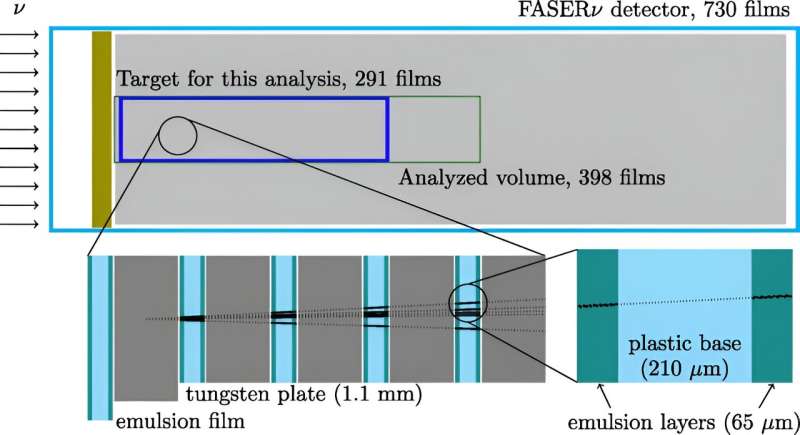This article has been reviewed according to Science X's editorial process and policies. Editors have highlighted the following attributes while ensuring the content's credibility:
fact-checked
peer-reviewed publication
trusted source
proofread
Neutrino interaction rates measured at unprecedented energies

A team including researchers from the Laboratory for High Energy Physics at the University of Bern has successfully measured the interaction rates of neutrinos at unprecedented energies using the Large Hadron Collider (LHC) at CERN. The study was published in the journal Physical Review Letters.
A better understanding of these elusive elementary particles can help answer the question of why there is more matter than antimatter in the universe.
Neutrinos are fundamental particles that played an important role in the early phase of the universe. They are key to learning more about the fundamental laws of nature, including how particles acquire mass and why there is more matter than antimatter.
Despite being among the most abundant particles in the universe, they are very difficult to detect because they pass through matter with almost no interaction. They are therefore often called "ghost particles."
Neutrinos have been known for several decades and were very important for establishing the standard model of particle physics. Nevertheless, most neutrinos studied by physicists so far have been low-energy neutrinos generated in specially constructed facilities.
The FASER International Collaboration, including researchers from the Laboratory for High Energy Physics (LHEP) at the University of Bern, has successfully measured the interaction rates of electron neutrinos and muon neutrinos (two subtypes of neutrinos) with atomic nuclei at the highest energy to date (1 teraelectronvolt or TeV).
The measurement was made using the FASERν detector of the FASER experiment, which measures neutrinos produced by particle collisions in the Large Hadron Collider (LHC) at CERN (European Organization for Nuclear Research in Geneva). Notably, this is the first observation of electron neutrinos in an LHC experiment.
"This research result is of great importance because the study of neutrinos at such high energies offers the possibility of gaining deeper insights into the fundamental laws of nature, studying rare processes and possibly discovering new physical phenomena," says Akitaka Ariga, particle physicist and head of the FASER group at the Laboratory for High Energy Physics (LHEP) at the University of Bern.
State-of-the-art forward detection technology
The FASERnu neutrino detector observes high-energy neutrinos produced by proton-proton collisions in the LHC. It is placed underground, 480 meters from the collision point and consists of alternating layers of tungsten plates (with a density comparable to gold) and emulsion films capable of detecting particle tracks with nanometer precision.
This 1.1 metric ton detector with state-of-the-art technology has been in operation since 2022. "In this study, we analyzed a portion of the data obtained by the FASERν detector in 2022, amounting to 2% of the total data collected so far, so we still have a long way to go," explains Ariga, who is leading the FASERnu project.
High-energy neutrinos the key to new physics?
In the FASER experiment, the number of neutrinos detected is to be increased a hundredfold over the next few years, addressing questions about the differences between the three neutrino subtypes and possible unknown forces. The tau neutrino, the third subtype, is difficult to produce and detect at low energies.
"The high energy of the FASER experiment makes it possible to generate and study tau neutrinos more efficiently. Little is known about these neutrinos and they could provide new physical insights," remarks Ariga. The FASER experiment will continue to collect data until the end of 2025.
Future experiments, such as the follow-up experiment FASERν2, are expected to collect more than 10,000 times larger amounts of data in order to significantly expand these investigations. The discovery of previously unknown forces or new particles is essential in order to be able to answer questions such as "Why does the universe consist mainly of matter and only very little antimatter?" or "What is dark matter?"
"Perhaps we will find 'undiscovered physics' with the high-energy neutrinos," says Ariga.
More information: Roshan Mammen Abraham et al, First Measurement of νe and νμ Interaction Cross Sections at the LHC with FASER's Emulsion Detector, Physical Review Letters (2024). DOI: 10.1103/PhysRevLett.133.021802
Journal information: Physical Review Letters
Provided by University of Bern





















